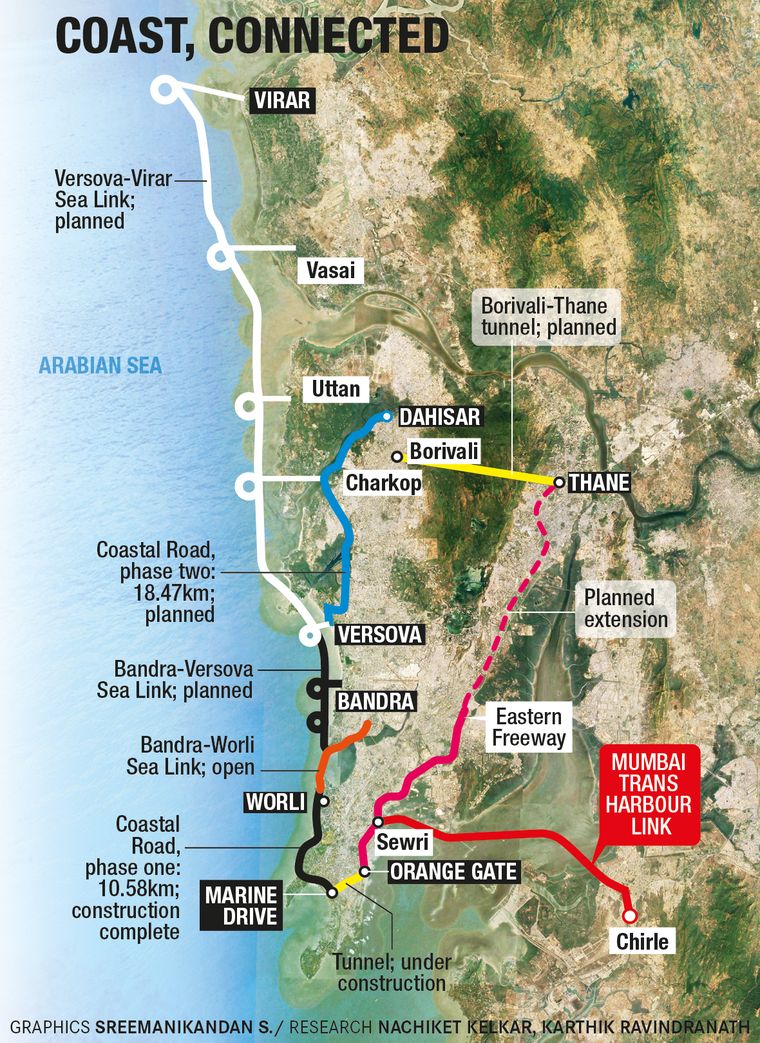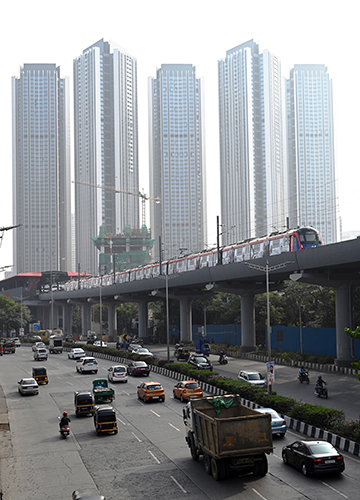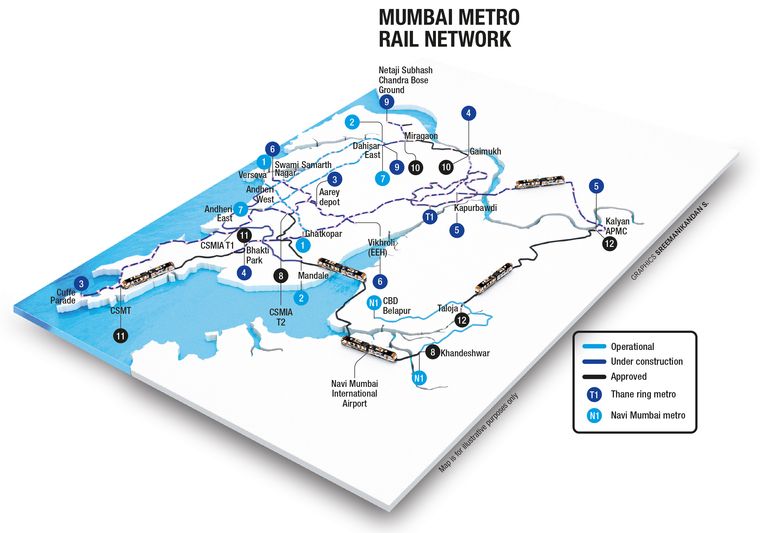In May 2023, Maharashtra Chief Minister Eknath Shinde and Deputy Chief Minister Devendra Fadnavis drove a Lexus SUV on the entire stretch of the Mumbai Trans Harbour Link (MTHL) during an inspection. Apparently, the drive was so exciting that they took turns and neither wanted to get out of the driving seat.
The longest sea bridge in India, the MTHL was commissioned when Fadnavis was chief minister; construction began in 2016. Opened to the public in January, it has reduced the distance between Sewri on the island city and Chirle near the Jawaharlal Nehru Port Trust (JNPT) in Raigad district to almost a third―from 60km to 22km. “The best thing about the MTHL is the non-stop 22km journey on the sea bridge,” said Saji S., who commutes 60km one way from his house in Ambernath to Mumbai every day.
For long, two bridges over Thane creek linked Mumbai to Navi Mumbai―the Mulund-Airoli connector and the Vashi connector. The MTHL is the third. “This bridge is on land, sea and mudflats in between the two,” said Dr Sanjay Mukherjee, metropolitan commissioner, Mumbai Metropolitan Region Development Authority. “The seismic strength of the bridge is two and half times more than the normal seismic activity of that region.”

The bridge is a six-lane highway that ensures quick connectivity from the city to JNPT, the under-construction Navi Mumbai airport, the expressway to Pune and the national highway to Goa. Shinde said the MTHL was a game changer for commuters and the economy. “We are connecting the MTHL to Worli sea link and to Nariman Point via the coastal road,” he said. “People living in Nariman Point will now be able to reach Panvel in just about 30 minutes.” It currently takes more than an hour.
The MTHL has given the city the opportunity to grow horizontally. It will be the engine of economic growth for Mumbai and the Mumbai Metropolitan region, said S.V.R. Srinivas, former managing director of MMRDA, who oversaw most of the work on the MTHL during his tenure.
Officially the Atal Setu, the MTHL faced many objections when the work started. “Environmentalists said the habitat of flamingoes would be destroyed,” said Fadnavis. “But we worked with Bombay Natural History Society and implemented mitigation measures. As a result the number of flamingoes has increased and the bridge also has been completed.”
The MTHL is also a bridge to Mumbai’s future. “Atal Setu will facilitate the creation of ‘Third Mumbai’ in the Navi-Mumbai Raigad region,” said Deputy Chief Minister Ajit Pawar. The government has facilitated MMRDA as the New Town Development Authority (NTDA) to focus on the growth of the areas that will be benefitted by the Atal Setu.
The Third Mumbai is an ambitious smart city that is envisaged in the area close to the upcoming Navi Mumbai International Airport. The project encompasses 124 villages in the Raigad district. Several villages from the existing Navi Mumbai Airport Influence Notified Area are also likely to be a part of the NTDA. The NTDA is expected to oversee an estimated 323 sqkm area in the Panvel-Ulwe-Uran region where the new airport and the MTHL will offer connectivity. It will feature housing projects, commercial complexes, data centres, IT knowledge parks and financial services hubs.
The new airport will connect the city to the rest of the country and the world. The foundation stone for the airport was laid in 2018. The Rs18,000 crore project, planned on 1,160 hectares, is the largest greenfield airport under development. Initially it would have a passenger capacity of two crore a year with one runway and one terminal. A second runway and additional terminals will be built over time and eventually, it will handle nine crore passengers.

Just as the MTHL is easing the commute from south Mumbai to Navi Mumbai and beyond, Mumbai Metro has now become a practical alternative to the overcrowded suburban trains for lakhs of Mumbaikars. The lifeline of commuters, the local trains have been running well over their capacity owing to the multi-fold increase in the number of travellers over the years, especially during peak hours. People in the suburbs are quickly switching to the clean, air-conditioned metro trains to travel to the city.
“Metro saves a lot of time,” says Sayali M., a regular commuter from Gundavali to Aarey. “If I take an autorickshaw on this route, it takes almost 50 minutes and costs around Rs150. I cover the same distance by metro in 15 minutes and it costs just Rs20.”
Mumbai Metro’s Line 3, which connects the northern suburbs at Aarey to Colaba, the city’s southern-most area, is probably the most crucial infrastructure project in the city. This Rs30,000 crore, 33.5km line, which is under construction, will have 26 underground stations and provide connectivity to major business centres like Nariman Point, Cuffe Parade, Fort and Lower Parel, the business district of Bandra Kurla Complex, and the industrial belt of SEEPZ/MIDC (Santacruz Electronics Export Processing Zone/Maharashtra Industrial Development Corporation).
Line 3 is expected to open this year―phase one from Aarey to Bandra Kurla Complex will open soon, and the second phase, from BKC to Cuffe Parade, six months later. A fully operational Line 3 would cater to 17 lakh passengers daily, said Ashwini Bhide, managing director of Mumbai Metro Rail Corporation. “Around 35 per cent [of road traffic] is expected to reduce. By 2031, around 5.54 lakh vehicular trips will be expected to reduce every day, which will cut the fuel consumption to the tune of 2.95 lakh litres a day. Around 15 per cent burden on suburban railways also will be lessened,” she said.
Currently, three metro lines are operational in Mumbai. Line 1 connects the suburb of Ghatkopar in the east to Versova in the west. This 11km line was opened in 2014 and carries four lakh commuters every day. The line 2A, between Dahisar and Andheri East, and the Line 7, from Dahisar to Andheri West, were opened last year. Seven lines are in various stages of planning and development. Bhide said that entire metro network would get completed in five to seven years. Line 3, the only underground line, is the toughest one, as it passes through some of the densely populated areas in Dadar and Girgaon.
Areas like Girgaon and Kalbadevi, among the oldest trading hubs in south Mumbai, have many old buildings that will soon be renovated. “We had to constantly engage with people, transparently share information and convince them that the project was not only to improve the public transport in the area, but also to improve the area,” said Bhide.
The building of the car depot for Line 3 in the Aarey Milk Colony area had become a flash-point, as environmentalists and local people opposed the felling of trees in the area for the project. The Maha Vikas Aghadi government under Uddhav Thackeray shifted the car depot to another locality. But when Eknath Shinde became the chief minister, the depot was shifted back to Aarey and the work picked up.
Slow execution has been a nagging issue for infrastructure projects in the city. The Line 2 of the Mumbai Metro is a classic example. In 2009, president Pratibha Patil broke ground for the line and the construction was to begin in 2010. It was delayed because of various reasons, including getting clearances. The work began in 2015 and the first phase, 2A between Dahisar to Andheri West (18.59km), opened only in 2023. The second phase, 2B from Andheri West to Mandale Depot (23.74km), is still under construction.
The work of the coastal road, connecting Worli and Marine Drive, began back in 2018, but it ran into many bumps. Fishermen in Worli protested it, fearing it would affect their livelihood, which eventually made the authorities change its alignment. The pandemic also slowed progress of the construction. The south-bound arm of the coastal road, from Worli to Marine Drive, is ready. The completion of the north-bound stretch (Marine Drive to Worli) will take longer.
Projects like the coastal road and MTHL have faced criticism that they are ‘elitist’ and do not benefit the common man. Bhide refuted it saying public transport was allowed on the MTHL and the coastal road. “On the coastal road, there is dedicated bus lane and bus stops,” she said.
The Marine Drive-Worli stretch is just one part of the coastal road project. It will meet the existing Bandra-Worli Sea Link at Worli. Further, there will be a 17.17km sea link between the western suburbs of Bandra and Versova. Being constructed at a cost of around Rs11,300 crore, this sea link is expected to be ready in four years. The plan is to eventually extend the coastal road to Virar in the north of the city. This Versova to Virar sea link will be 43km long, but it is years away. Once ready, it will decongest the existing road network, including the western express highway and the Mumbai-Ahmedabad National Highway.
Work is also on to connect the suburbs of Borivali and Thane through a twin tunnel project under the Sanjay Gandhi National Park. This project received wildlife clearance in October 2023. Currently, it takes more than an hour to drive from Thane to Borivali. These tunnels will cut the time by half. The 11.8km of tunnels and approach roads and subways are expected to cost around Rs16,600 crore.
Another underground tunnel is planned between the existing freeway at Orange Gate near the Mumbai Port to the coastal road at Marine Drive.
The residential housing segment will be one of the biggest beneficiaries of the improving connectivity, as top developers are looking at emerging markets like Panvel, Belapur and Upper Kharghar to expand their portfolio and infuse fresh supply into the city. “With the upcoming connectivity, there will be an increase in new development nodes such as Panvel, Uran, Kharghar, and Karjat (on the outskirts of Mumbai), with access to airports, roadways, and railway corridors,” said Niranjan Hiranandani, managing director of real estate developer Hiranandani Group. He expects developers to build affordable housing with better ecosystems owing to the better connectivity to the peripheral suburbs.
The island city might witness development in other spheres as well, said Rajashree Murkute, senior director, CareEdge Ratings. The seamless connectivity from south Mumbai to Navi Mumbai and beyond will lead to the second phase of de-localisation and de-concentration. The first phase was the movement of offices from south Mumbai to Bandra Kurla Complex.
“Mumbai’s infrastructure development, especially connectivity, is catching up rapidly across the city. What may emerge ahead will be more utility-focused projects offering better inter-city roads, water supply, gas pipeline connections and superior drainage systems. So the fallout in the form of overall socioeconomic benefits will be amplified,” said Murkute.
It is estimated that every rupee spent on infrastructure development results in an increased contribution of Rs2.5 to Rs3 to the GDP. The massive push that infrastructure is getting in Mumbai will not just make living more comfortable for its people, but also go a long way in developing the economy of the region, the state and the country.
Many people, however, are of the opinion that a lot more is needed to fix Mumbai’s woes. “You are making bits and pieces here and there,” said Gulam Zia, senior executive director at consulting firm Knight Frank. “It has been 13-14 years since the Bandra-Worli sea link was opened. The Versova to Bandra sea link has not yet been developed; it will take another four years, at least.”
And there is a call to make development sustainable and inclusive. “Government data says 50 per cent people walk to work. So, the first thing we need to invest in is proper footpaths everywhere,” said Rahul Kadri, principal architect of IM Kadri Architects. “If you look at sustainability goals, we need to encourage walking and cycling. That needs proper space and that brings pollution down.”
Kadri wanted significant investments in public transport. “Any city that solved transportation problem has done it through public transportation,” he said. “In Mumbai around 12 per cent people use car. If you bring it down to 8 per cent, pollution will come down. Public transport should be good enough that people would not need a car.”
Development projects often eat into open public places like parks and playgrounds. Kadri stressed on the need to develop and preserve open playgrounds in the city. “The kind of open spaces we need are maidans (playgrounds) and simple parks,” he said.
Mumbai had fallen behind Delhi, Bengaluru and Hyderabad in infrastructure development. “Princess Street flyover was the first in India,” said Mukherjee. “At that time, the infrastructure of the city was ahead of its time. Then the city grew so rapidly that infrastructure fell acutely behind. So the need is to reboot Mumbai and reshape the MMR region so that organised development and growth can take place there.”





